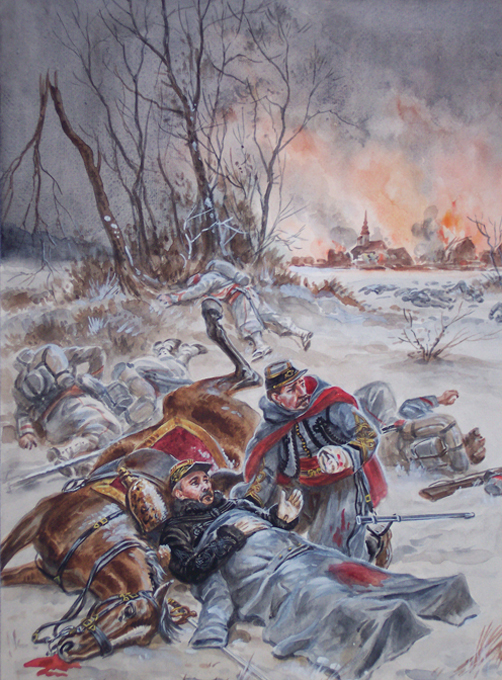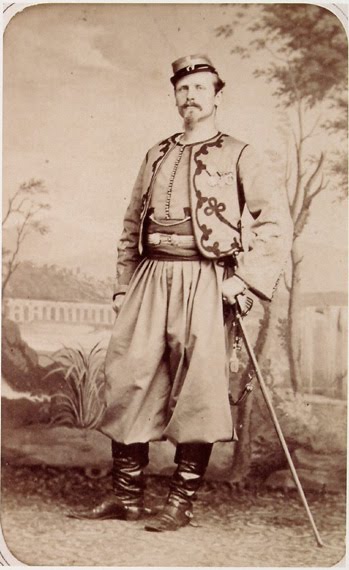The battle of Loigny, one of the most bloody encounters of that terrible winter, was made memorable by the heroic attitude of the Pontifical Zouaves, commanded by Charette, who was himself under the orders of General de Sonis, an eminent leader and a fervent Catholic. After the battle, Abbé Theuré’s house was filled with wounded soldiers, whose sufferings were increased by the bitter cold, for during the night snow had fallen heavily on the frozen ground.
Early on December 3d, General de Sonis, who had spent the night on the frozen ground, was carried into the presbytery. Abbé Theuré never forgot the sight, “I seem to see him now,” he used to say, “pale as death, his face and clothes covered with snow and frost. With much difficulty he was undressed and laid on a bed in my room.” One of his legs was frozen, the other so grievously wounded that on December 4th it became necessary to amputate it. Sonis only remarked when informed that the operation was necessary: “God’s will be done. Doctor do what is necessary only leave me leg enough to ride and serve my country.” The Curé assisted at the operation, during which the general, who had been given an anesthetic, prayed aloud or gave orders to his men.

General de Sonis and many other soldiers lay on the battlefield. He survived but had his leg amputated. (Painting by Eugène Lelièpvre)
A strong friendship sprang up between the general and the priest, whom Sonis used to call “my good Samaritan” and among the horrors of those days of nursing the Abbé Theuré learnt, with patriotic pride, how the Papal Zouaves had honored the banner of the Sacred Heart during the battle. This banner, embroidered by the Visitation Nuns of Paray-le-Monial, was given to the Zouaves; it was displayed in front of the army at a critical moment. General de Sonis, perceiving that some of his men belonging to the regular army, were loth to march forward, appealed to the Papal Zouaves to lead the advance, and to encourage the wavering troops. He picked out three hundred among them to follow him; out of these 198 were killed, and ten officers out of fourteen were mortally wounded.
The banner of the Sacred Heart was entrusted to M. de Verthamon; then, when he fell, to the two Bouilles, father and son, and when these, too, were grievously wounded, to a Zouave named Parmentier, who saved it from falling into the enemy’s hands. The wounded bearers of the banner, the Bouilles and young Verthamon, were, like their general, carried to the presbytery of Loigny, where as soon as Madame de Sonis discovered her husband’s whereabouts she hastened to rejoin him. The Curé worked day and night among his wounded guests; their misery was great, but owing to his initiative provisions were sent to Loigny by some charitable persons at Chartres. “The devotedness of this priest is beyond all praise,” wrote General de Sonis. “Day and night he is in the ambulances. He gives all that he possesses, he gives himself. He saves our bodies and our souls, we only exist owing to the alms that be procured for us.” To the general’s great joy, the good Curé said Mass in his room on the feast of the Immaculate Conception.

Photograph of the vicar of Loigny-la-Bataille, Father Theuré, who collected various objects from the battlefield and formed the Musée de la Guerre 1870 Loigny-la-Bataille.
“The Curé’s devotedness is incomparable,” wrote Madame de Sonis, who during three months, slept on the ground close to her husband’s sick couch. The memory of the battle of Loigny and of the scenes of horror and heroism, in which he had played a part, never left the Abbé Theuré. After the war was over, he set to work to rebuild the village and its church, and conceived the happy idea of making the new edifice a memorial church, where the bones of the heroic dead should rest in the shadow of God’s sanctuary. General de Sonis, who died the death of a saint, on August 15th, 1887, was on September 22d, brought to Loigny, and Abbé Theuré presided at the ceremony. Upon the general’s coffin lay his sword, his decorations and the bloodstained banner of the Sacred Heart, and close by knelt the dead soldier’s eight children, four of his sons wearing the military uniform. Upon the tomb, by the general’s own wish, the following short inscription was engraved: Die XXII Sept., 1887—in spem vitæ—hic depositus est—et requiescit—Miles Christi Gaston de Sonis—General de division né le 27 Aout, 1825—décédé le 15 Aout, 1887—Priez pour lui.

The Church Saint-Lucain à Loigny-la-Bataille. Photo by Bertrand Chabin. Rebuilt on the sight to replace the one destroyed during the battles of Loigny-la-Bataille, December 2, 1870. The walls of the apse and the vault are decorated with paintings with historical and religious motifs, and covered with commemorative marble plaques bearing the names of the 700 recognized soldiers. The crypt preserves the tombs of the Generals of Sonis and Charette, as well as the bones of 1,300 soldiers.
A little more than a year ago, General de Charette’s body was laid in the crypt of Loigny by the side of his brother in arms; now the devoted priest, the friend of both, has, in his turn, gone to receive his reward, and his mortal remains have been brought to rest in the church that owes its existence to his zeal. He never sought notice or honor, and when the war was over he quietly resumed his labors as a country priest. But his name had become a household word among his countrymen. The Pope bestowed upon him the title of Monsignor, and the dignity of apostolic protonotary, and the anti clerical Government of France, for once, recognized the services of a priest and gave this true patriot the cross of the Legion of Honor. On January 15th, the Abbé Theuré’s mortal remains were buried, with due honor, in the crypt of Loigny, where he sleeps his last sleep close to his friends, Sonis and Charette.
Short Stories on Honor, Chivalry, and the World of Nobility—no. 703









